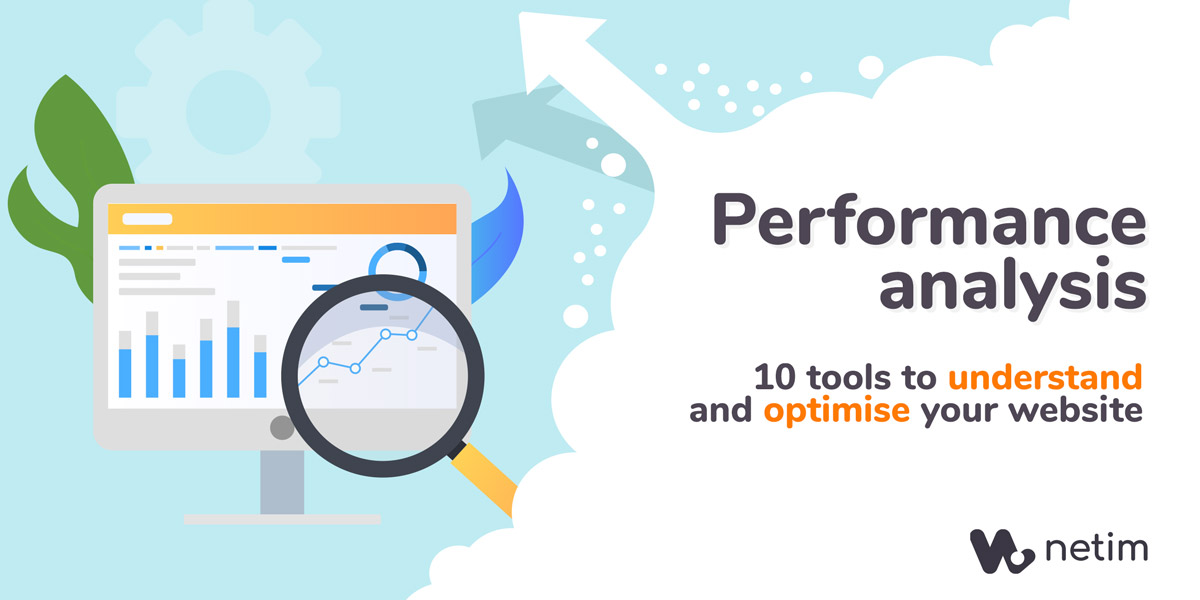Performance analysis, 10 tools to understand and optimise your website.
How to build your website's reporting, which tools are used to carry out a performance analysis?

When creating your website, you have a specific goal in mind, dedicated objectives. Whether it is sales, a showcase for your business, or simply personal visibility, you need to know if you are approaching these objectives.
To make it easier for you, Netim has selected several free tools that are accessible to everyone to carry out your reports. While performance analysis may seem overwhelming at first, it’s actually a matter of understanding its functioning from the start to monitor the right key indicators.
What does the performance analysis of a website involve?
How do I know if my site is efficient?
The first question you should ask yourself is “performing” compared to what? What are your website’s objectives? This is what is called a digital strategy. Indeed, this first step is essential to the smooth running of the next step. Is your website a commercial site? In which case its goal would be to increase sales. Is your site a business site? In which case, the objective could be to generate leads (via a subscription to the newsletter or contact form).
As you will have understood, depending on the objectives and the type of digital platforms, the way of interpreting performance will change.
What indicators should be tracked?
KPIs (Key Performance Indicators) allow you to measure the impact of the actions taken. They are quite numerous and can be adapted according to your objectives. They allow you to calculate the return on investment (ROI) and therefore to monitor and adapt if needed.
Here are a few examples of KPIs to measure the engagement of your visitors:
- Number of visitors and duration of each visit
- Pageviews
- The origin of your visitors
- The conversion rate (if you are a merchant site: how many visitors versus how many end customers for example).
Of course, there are many other performance indicators. They allow you to understand and analyze Internet users’ behavior to improve your website and reach your objectives.
What tools are used to measure these indicators? You will have understood it, monitoring and analyzing these performance indicators is essential to the good evolution of your website. To do so, there are free tools provided by both Google and by private organizations.
The tools provided by Google for performance analysis
It’s hard to talk about optimization and KPIs without talking about Google. Over the years, many platforms were developed allowing website owners, from advanced to novice, to monitor the performance of their digital platform.
Google Analytics, the fundamental of online performance analysis

This tool will allow you to analyze the traffic on your website. This means that you will be able to study the traffic in real-time or globally, visitors’ origin (social media, SEO, Google search), the time spent on your site, the bounce rate, the number of pages viewed, etc.
These indicators allow you to understand how users behave on your site. Do they spend time on your site without adding items to their carts? Maybe you should review your conversion tunnel, add CTAs (call to action) to increase purchase. These elements encourage you to rethink the user experience (UX) by providing concrete improvement ideas.
Thanks to Google Analytics you can also understand how your visitors get to your site, on which page, what queries they have entered on the search engines, etc. For example, if the bounce rate on the same page is high, it means that this page does not meet the visitor’s needs correctly. Therefore, it will require a review of its content in order to lower the bounce rate and attract a more qualified audience.
Google Search Console, for a high-performance website

Google Search Console provides you with indicators to check your site’s good health. In other words, this interface will highlight the faulty points on your site. For example, blocked pages, errors, URLs that do not work or do not display the page, etc.
It will also give you an idea of how Google’s robots analyze your site and how often they come and go. This tool is particularly useful for analyzing your SEO (Search Engine Optimization).
Google Tag Manager, the most technically advanced

This tool goes further in studying user behavior. How does it work? By using a tag system to analyze users’ browsing habits step by step. The big advantage of Google Tag Manager is that it offers an interface for managing these tags.
Normally, monitoring the performance of a site with such precision would require a developer’s intervention. The developer would put code fragments in the precise places that need to be analyzed. You could control, for example, the click on such and such a button, the access to a contact form, etc. With Google Tag Manager, no such intervention is required. You can choose the type of tag you want to use and the data comes to you on a single interface.
A Google tool to allow you to test your mobile optimization
Today, the mobile display is taking more and more space in our digital content habits. It is therefore essential to ensure that your site is displayed correctly on this media.
Simply enter the URL of your site to launch the test and see the points that need improvement. A complete report is created and a preview of the mobile display is also provided.
Other tools to help you carry out a performance analysis of your site
While Google’s tools are particularly effective for your analysis and reporting, other sites offer to provide an overview of the improvements to be made. They can be a good starting point for identifying “flaws” in your site.
Backlink Checker, are you a reference in your field?

This site allows you to find out how your content reaches the Internet. In other words, who is making links towards your site? Are these sites themselves references in their fields? To which pages of your site are there the most links?
All these answers will give you an idea of the type of content that attracts your online visitors. But, above all, backlinks are essential to increase your search engine optimization.
SEO site checker, for technical performance analysis of your SEO

This platform allows you to make a complete audit of your site on a technical SEO aspect. Indeed, your ranking on the search engines can sometimes fail due to a lack of technical optimizations. Numerous analyses are provided including broken links, redirection system, page loading speed, site structure, alt tags, etc.
SEO Optimer, another tool to control your SEO

This second tool is complementary to the first one. It also provides a complete audit but with a more educational aspect. It explains point by point the elements that can slow down the progress of your site on search engines. In addition, it provides a guide with explanations to fix the detected mistakes and a PDF file to save the recommendations.
Answer the public, what questions do Internet users ask themselves?

This platform allows you to find out, by using a keyword, which queries are the most frequently typed in by Internet users. Whether it’s an affirmative sentence, questions, prepositions, comparisons, your keyword is twisted around to give you a global view of what people are looking for.
As a result, you can create content and pages that meet these needs.

In the same way, this site allows you to have a global vision of the keywords associated with a target query. Thanks to this generator, you will be able to see about a hundred keywords and an estimated search volume.
In addition, on the right-hand tab, you will be able to discover around fifty standard questions containing the keyword previously seized.
Keyword surfer, a Chrome extension

This extension, powered by Chrome, allows you to see the volume of any query directly from the search bar. It also allows you to combine a local and a global volume (the global volume is not really global but combines searches from 19 countries to date).
A considerable time saving and particularly useful if your business is expanding internationally.
So are you ready?
You’re ready for new analyses! With this range of tools, there is no doubt that you will be able to study and deduce the improvements you need to make to your website. Monitoring performance indicators has become a standard practice today, so don’t let yourself be overtaken!
Why is it so important? Because, firstly, you will be able to understand the behavior of your audience and achieve your objectives more quickly. And secondly, many of these performance indicators are used as a gauge by Google to give bonuses or penalties to your search engine optimization.
Satisfying your potential customers and acquiring new ones thanks to search engine optimization are two good reasons to start analyzing the performance of your site!



